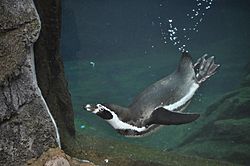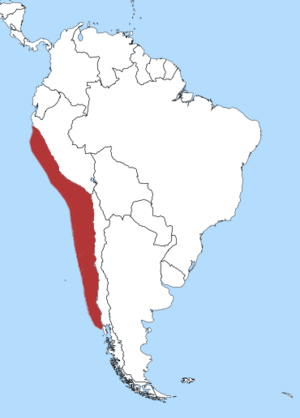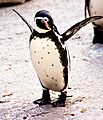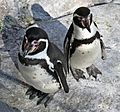Humboldt penguin facts for kids
Quick facts for kids Humboldt penguin |
|
|---|---|
 |
|
| at Woodlands Zoo, Seattle. | |
| Conservation status | |
| Scientific classification | |
| Kingdom: | |
| Phylum: | |
| Class: | |
| Order: | |
| Family: | |
| Genus: |
Spheniscus
|
| Binomial name | |
| Spheniscus humboldti |
|
 |
|
| the range is in red | |
The Humboldt penguin (Spheniscus humboldti) is a type of penguin. It has a plain white belly. It might have a few black spots on its belly. Its beak can be orange with a hint of green. There are fewer than 10,000 Humboldt penguins left in the wild. They live along the coasts of Chile and Peru.
These penguins drink sea water. Their favorite food is small fish. A female Humboldt penguin can weigh up to 4.5 kilograms (about 10 pounds). A male can weigh up to 6 kilograms (about 13 pounds). Their bodies are made for living in the water. Most Humboldt penguins can live for up to 20 years. They got their name from a famous Prussian explorer, Alexander von Humboldt.
Contents
Where Humboldt Penguins Live
Humboldt penguins are found along the coasts of Chile and Peru. They live in areas influenced by the cold Humboldt Current. This current brings lots of fish, which is great for the penguins.
What Humboldt Penguins Look Like
Humboldt penguins have a distinct black band across their chest. This band separates their white belly from their black back. They have a black head with a white stripe. This stripe goes from behind their eye down to their throat. Their beaks are black with a pinkish-orange patch at the base.
Life in the Wild
Humboldt penguins are excellent swimmers. Their bodies are streamlined for moving fast underwater. They use their strong flippers to propel themselves. They use their webbed feet to steer.
They build their nests in burrows. These burrows are often dug into soft ground. Sometimes they use natural caves or rocky crevices. In the past, their droppings were collected. These droppings are called "guano." Guano was used as a natural fertilizer for gardens.
Conservation Status
The number of Humboldt penguins in the wild is decreasing. This is why they are listed as "Vulnerable." This means they face a high risk of becoming extinct. Threats to these penguins include:
- Overfishing, which reduces their food supply.
- Habitat loss, especially where they nest.
- Climate change affecting ocean currents and food.
- Pollution.
Efforts are being made to protect these special birds.
Images for kids
-
A pair "kissing" at Cotswold Wildlife Park
-
At the Dublin Zoo
-
Humboldt penguin during moult at the Cornish Seal Sanctuary
-
At the Oregon Zoo
-
At the Woodland Park Zoo
-
In captivity at Brookfield Zoo
See also
 In Spanish: Pingüino de Humboldt para niños
In Spanish: Pingüino de Humboldt para niños
















